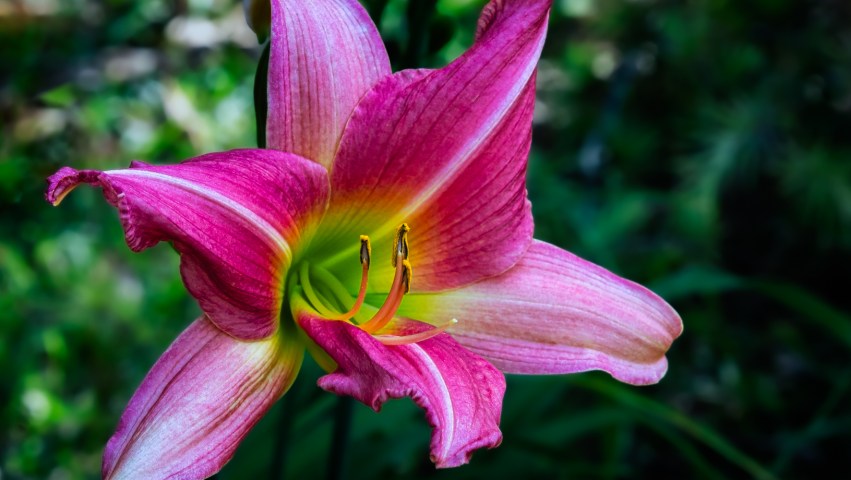From A Passion for Daylilies: The Flowers and the People by Sydney Eddison:
“Daylilies are native to China, Japan, Korea, and Eastern Siberia. Long before the birth of Christ, they were mentioned as an anodyne for grief in the religious writings of Confucius, China’s greatest philosopher. By the fourth century A.D., they were being used to relieve physical as well as mental pain. A Chinese herbal of the period makes extravagant claims for juice extracted from their roots: ‘It quiets the five viscera [the heart, lung, liver, kidney, and stomach], benefits the mind and strengthens the will power, gives happiness, reduces worry, lightens the body weight and brightens the eye…. Now people often collect the young shoots and serve as a pot green. It gives a pleasant feeling in the chest.’ In addition, the thick roots were boiled and eaten like potatoes.
“It wasn’t until the seventeenth century that daylilies became cherished ornamentals for the pleasure garden. In a Chinese gardening treatise published in 1688, author Chen Hao-tzu describes a plant with leafless flower stalks (scapes in daylily parlance) and arching foliage: ‘The flower when it first appears, resembles the beak of a crane, then it opens with six radiant segments, yellow dusted red, opening in the morning and withering by night.’ This description still fits some of the old-fashioned daylilies.
“No one knows by what circuitous path these plants came to Europe in time to be recorded and described in medieval herbals…. However they traveled, the ubiquitous orange daylily (Hemerocallis fulva) and its yellow companion, the lemon lily (H. Lilioaspbodelus) had arrived in Europe by the sixteenth century. A hundred years later, this same pair crossed the Atlantic with pilgrims and took root in American soil. From the eastern seaboard, the tougher, more adaptable tawny orange daylily moved west with the settlers, earning itself the name of homestead lily. And during the late nineteenth century, a root or two of this hardy species wound up alongside the porch of a midwestern farmhouse. Here, it became an object of interest to young Arlow Burdette Stout, whose mother had planted it….
“At the beginning of the twentieth century, a handful of breeders using half a dozen wild species were producing yellow and orange hybrids. Today, hundreds of hybridizers working with an enormous gene pool are producing a thousand new cultivars a year. (Cultivar combines the words cultivated and variety to distinguish garden plants from naturally occurring species.) Previously unknown colors and designs are now emerging from nurseries and backyards all around the country, thanks to Dr. Stout and Hemerocallis fulva.”
Hello!
This is the second of two posts with photos of a double form of the daylily Hemerocallis fulva from Oakland Cemetery. The first post is Orange Double Daylilies (1 of 2).
Unlike those in the previous post, where they were planted as part of a precisely designed garden memorial…

… I found the daylilies in these photos in one of the “wild” sections of the property, where several different kinds of plants and flowers live together in a transitional space, arranged and layered for visual appeal. Their presence among densely planted variegated grasses produced interesting contrasts between the bright orange flowers and the green and white or gray stripes in the background, while that grass hid most of the daylily stems and leaves. I took about half of these photos using the gray/green grass as a backdrop, then changed positions so I could focus more closely on individual blooms.
The impressive height of these daylilies meant that they were easy to photograph not far below eye level, so zooming in reveals more of the structure and detail than I could capture from a distance in the previous post. Here we get a better look at not only the blended shades of orange, yellow, and red present in each flower, but also get a closer look at their structure. The layered petals appear to unfold like ribbons, with lower petals terminating in flat or rectangular shapes, and upper petals drawn to a point that is common to many daylilies, including the single form of Hemerocallis fulva itself. In early stages of blooming, each flower has a few upright petals surrounding and protecting its young stamens and pistils, which fold down to the lower layers as these reproductive segments strengthen and mature.
The shades of orange in these daylilies are remarkably stable; you can increase or decrease saturation substantially in Lightroom and still end up with an image that contains adequate contrast, detail, and color variation. That’s actually very common among orange flowers, whose colors — spectrally wide-ranging between yellow and red — are densely packed into the flower petals’ cells. Imagine, if you will, how these colors don’t just exist at the surface level, but at multiple microscopic levels stacked on top of each other. Luckily, our eyes (and our cameras) detect and perceive all these layers, even if they don’t actually register to our vision as multi-layered or multi-dimensional.
Thanks for reading and taking a look!



































































































































